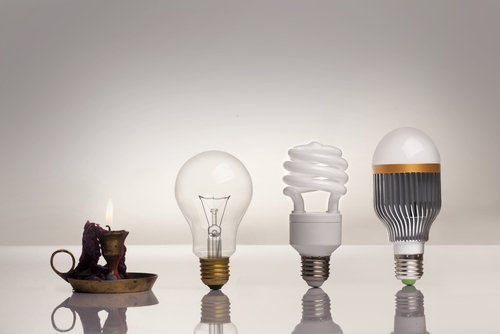LED smart technology reshapes the business of lighting
Written by Mark Sait
Posted on August 7, 2015
The business of lighting is being transformed by LED technology as the big players wrestle with change.

Lighting is no longer simply about illuminating spaces with adequate, even sometimes inadequate, lamps, tubes and bulbs.
The business is shifting with astonishing pace towards LEDs and the technology’s inherent capacity for new applications, based as it is on microchip engineering. The major companies such as Philips, General Electric and Siemens are reshaping their structures in response to the opportunities and challenges of LEDS.
At SaveMoneyCutCarbon we keep a close eye on developments in LED lighting, ready to offer new solutions that provide what people want at a favourable price. That’s why, for example, we partner with Soraa, the innovative company founded by Nobel prize winner Professor Shuji Nakamura, to provide full spectrum LED lighting.
Our search for highest quality has also led us to partner with Verbatim, another company at the leading edge of LED lighting. Verbatim, for example, offers an excellent, precise visual presentation of colours in its LEDs compared to conventional halogen bulbs.
Smart technology
The quest for best quality illumination from LEDs that goes beyond straightforward brightness is being joined now by other services that reveal the technology’s intrinsic smartness. The bulbs, lamps and tubes that currently are pretty dumb will be replaced over the next few years by models that can connect to the internet and mobile networks.
Actually, some of that change is occurring right now as the concept of “internet of things” moves beyond hype and into practical, useful mode. This will take some time to shift fully as with all shiny new things but there are already just a few interesting examples of where we are heading in lighting.
The traditionally snail’s pace industry, which moved so slowly for the very good reason that little changed in lighting technology with little pressure in the market for rapid innovation.
The filament bulb worked well enough in a time of cheap energy and abundant seemingly inexhaustible natural resources. Halogen, fluorescent and other lighting developments provided small-step changes in response to particular needs as the industry reaped continual rewards of the need to replace bulbs fairly regularly.
But the advent of LED technology changed all that and the timing was remarkably good. LED lights have an incredibly long lifespan, if they are manufactured well. As we advise customers, shoddily made, extremely cheap LED lights are a recipe for failure. And fail they do. However, component costs continue to drop dramatically each year, which is having a very positive effect on pricing.
Energy savings
LED lights also use a fraction of the electricity consumed by filament bulbs and tubes. That energy saving of up to 85% has quickly caught the imagination of the consumer in businesses and other organisations and at home.
It’s not only reduced costs year after year but also the knowledge that fitting LEDs reduces impact on the planet with lower carbon emissions that makes the technology so appealing. The era of cheap energy with no regard to environmental impact is over.
With these drivers, it is not so surprisingly that the sector is being shaken up, with the dominant lighting companies restructuring their businesses and focus on smart lighting – or move out of the sector altogether.
It’s not that the traditional big players got caught by a technology shift so much as price pressures from astonishingly fast-growth Asian LED production centres forced them to take a radical approach in the context of a global market for LED lighting growing by 35 % last year to a value of around $32.3 billion. The LED share of the lighting market will reach 50% by the end of this year, rising to 84% by 2020, according to analysts Frost & Sullivan.
Smart solutions
The big players – and some competitors – see the commercial future as being based with smart solutions where the LED light fitting, whatever shape, provides other services than simply illumination.
Examples of this are controlled multi-colour lighting operated by smartphone and tablet, which is an RGB LED solution that we have installed in hotel interior and exterior settings as well as theme parks.
A Financial Times report this week highlighted another smart service development, with LED lighting from Philips providing shoppers in a Lille hypermarket guiding customers to special offers by sending a location signal to their smartphones.
Retail is one area that has increasingly moved into LED technology but there is so much more scope for adding value through smart applications while reducing costs and improving sustainability.
LEDs are being fitted almost everywhere with the retail sector taking a 15.6% share of the global total the Financial Times report advises..Homes account for 34% with offices at 8.6%, hospitality at 5.3%, Industrial 2.1% and architectural currently at 15.2% with outdoor at 19.2%.
Smartphone control
In the domestic market, smart lighting applications are being championed by Philips through its HUE offering that enables people to control and colour-change LEDs with their smartphones. It also can connect to video games, and flash lights red when enemies attack! It’s a light-hearted way of demonstrating potential uses.
It’s interesting, then that Philips is to float its lighting solutions business – the world’s biggest – as a standalone company next year, to focus on its consumer lifestyle and healthcare offerings.
The FT report also signals changes in the outside world with street lighting becoming more sentient and signalling, for example, when a parking space is available.
It is these moves towards smart infrastructural developments that are fundamentally reshaping the lighting sector. The business of illumination has never been so much fun and the future promises a wealth of innovation and opportunity.